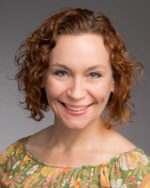
By Amy Moehnke
On the afternoon of June 7, I found myself sitting on the ground. I was at Huston- Tillotson University among a sea of mask-covered faces listening to the lineup of speakers at that day’s Black Austin Rally and March for Black Lives. I had expected to be hot (it was June in Texas, after all), I had expected to walk a lot (it was a march, after all), and I had expected to confront some tough realities (we were there because people are being killed, after all). I had not expected to sit down.
But I did sit down because the black organizers of a rally that was designed to center black bodies and black voices asked me to. I was not the only one asked to sit down, of course. All of the white people present were asked to do this. And so we did. We sat down and we listened. We listened to black people telling some hard truth.
We listened to Dr. Colette Pierce Burnette, the president and CEO of Huston Tillotson University, speak about how the historically black university had occupied a critical space in Austin (since 1875) while at the same time being woefully ignored and underfunded- she called it the step-child of Austin’s college and university family.
We listened to Brenda Ramos talk about the unnecessary and unjust killing of her only child Mike Ramos at the hands of Austin police officers in April.
We listened to Chas Moore, the founder and president of the Austin Justice Coalition telling us that if things are going to change we white people are going to have to be willing to give up some of our white privilege.
Now, that bit about giving up white privilege, that’s a hard one for us white folks. Even for those of us who recognize that we have white privilege, there’s a real sense of not knowing what surrendering some of it looks like in actual practice. The Rev. Canon Stephanie Spellers offers us this help: “Surrendering white privilege equals going into the spaces where you are not in control, going into the spaces that have been defined by that “Other”, by the oppressed, and laying your own skills, your gifts, your heart at the feet of the movement that they have defined.”[1]
For this white woman, sitting down and listening at the rally that centered black bodies and black voices was one part of this. But then I was invited to enact it.
When the speakers had finished sharing, Chas Moore gave directions for how we’d begin to make our way off of the Huston-Tillotson campus and onto the streets for the march. “Black people”, he said, “you go first.” “White people, you stay where you are and let the black people go in front of you. Then you follow them, and you get on the sides of them. You get behind them and walk alongside them.” Our job, MY job was not to lead, but rather to follow. And our job, MY job, if I was willing to accept it, was to put my white body in place to protect the black bodies from harm of any kind.
By putting my white body in the place that was most helpful for the black bodies there, I was indicating my “with-ness”. I was practicing what The Rev. Dr. Kelly Brown Douglas calls “solidarity”, a concept that communicates that we are all in the struggle for a more just future; that we are all in solidarity with God in mending the earth. Solidarity starts with action, with showing up, with having actual skin in the game.
Douglas says, “We show up in the places where Jesus would show up, where we see Jesus. Jesus always showed up where people were crying out for wholeness, for freedom. God showed up. God heard Israel’s plea and cry and showed up.”[2]
Showing up can look like a lot of things. For me, on June 7 it looked like going to a rally/march and doing what was asked of me even when it was not the thing I thought I’d be doing. For me, these days it looks like using my platform to encourage others to enter the work of showing up and being with in the way that Spellers and Douglas describe and that our black brothers and sisters ask us to. What might showing up look like for you?
[1] https://www.facebook.com/episcopalian/videos/2908859682556066/
[2] https://www.facebook.com/episcopalian/videos/2908859682556066/

3 Responses
This is such a thoughtful summary of that beastly hot afternoon. I, too, was there, and sat down at Chas’ direction. And knelt in one knee. I found it all very powerful, and your essay has given me words to describe that feeling. It looks s a challenge to not just recognize but to give up white privilege. Amy, thank you for taking the time to write this piece.
Thank you!!!! Lessons to learn.